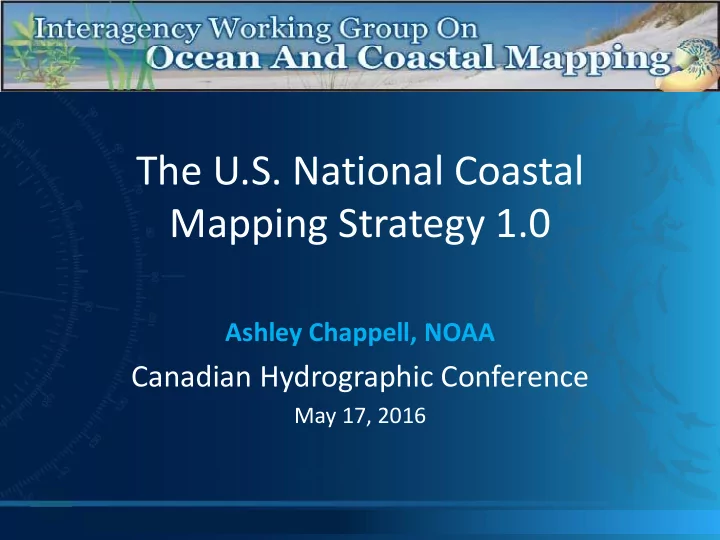

The U.S. National Coastal Mapping Strategy 1.0 Ashley Chappell, NOAA Canadian Hydrographic Conference May 17, 2016 1
The Interagency Working Group on Ocean and Coastal Mapping (IWG-OCM) • Co-chaired by NOAA, USGS, WHO: NOAA and USACE USGS • Charged with facilitating “the USACE coordination of ocean and NAVO coastal mapping activities and BOEM avoid[ing] duplicating NSF mapping activities…” NGA • Ocean and Coastal Mapping USCG Integration Act of 2009: EPA develop an “Ocean and FEMA Coastal Mapping Plan” NASA • National Ocean Policy: and other appropriate develop a topobathy lidar Federal agencies plan, National Coastal involved in ocean and coastal mapping. Mapping Plan 2
National Coastal Mapping Strategy 1.0 Coastal Lidar Elevation for a 3D Nation • GOAL: – To survey/map the Nation’s coasts/nearshore areas for multipurpose use – Repeat • Requires: – Coordination – Broad Range of Partners – A Plan 3
National Coastal Mapping Strategy 1.0 Coastal Lidar Elevation for a 3D Nation • Focus initially Uses of Bathy Topo Lidar Data : on coastal Shallow water bathymetry Coastal vulnerability bathy-topo Shoreline delineation assessments Topobathy DEM’s Infrastructure assessment Lidar Regional sediment Tsunami inundation management modeling • Version 2.0: Land/water interface Emergency response mapping Scientific research on – Offshore/OCS Habitat mapping processes of coastal change Bottom type detection Coral reef ecology – Acoustic Coastal erosion monitoring Coral reef genesis – Aerial Navigation/Charting Ecosystem connectivity photography, USGS analysis of 2012 NEEA Study ROI of lidar data, HSS based on multiple-use requirements /uses 4
National Coastal Mapping Strategy 1.0 Coastal Lidar Elevation for a 3D Nation Four Components: • Annual/Regional Coastal Mapping Summits for coordination • Common standards; • Whole life cycle approach to data; • R&D on new tools/techniques for data collection and use. 5
National Mapping Coordination • Great visualization tool for understanding requirements, plans • NOAA/USGS/USACE and partners worked to maximize Sandy topobathy lidar data collects • Eg. USACE worked with USGS and WA stakeholders to discuss overlap requirements, modify plans for best outcome
National Coastal Mapping Strategy 1.0 Component 2: Common Standards Vertical accuracy coefficients a,b as Nominal Point Bathy Lidar in Source Pulse Density Example Applications Quality Level sqrt(a^2+(b*d)^2)) Spacing (m) (pt/m 2 ) Detailed site surveys requiring QL0 B Bathymetric 0.25, 0.0075 ≤ 0.7 ≥ 2.0 the highest accuracy and highest Lidar resolution seafloor definition; QL1 B Bathymetric 0.25, 0.0075 ≤ 2.0 ≥ 0.25 dredging and inshore engineering surveys; high- Lidar resolution surveys of ports and harbors Charting surveys; regional QL2 B Bathymetric 0.30, 0.0130 ≤ 0.7 ≥ 2.0 sediment management General Lidar bathymetric mapping; coastal QL3 B Bathymetric 0.30, 0.0130 ≤ 20 ≥ 0.25 science and management applications Lidar Change analysis; deepwater surveys, environmental analysis QL4 B Bathymetric 0.50, 0.0130 ≤ 5.0 ≥ 0.04 Recon/planning; all general applications not requiring higher Lidar resolution and accuracy 7 7
National Coastal Mapping Strategy 1.0 Component 3: Common data management procedures "Whole Life Data Cycle" Data collection Approach Long-term, Validation proper and secure archiving Data Dissemination processing Stewardship 8 8
National Coastal Mapping Strategy 1.0 Component 4: Consensus on targeted research and development Topographic /bathymetric lidar and other coastal mapping technologies are rapidly evolving Federal coastal mapping R&D programs critical Smart to leverage one another’s capabilities and stretch limited research dollars Mutual interest areas include: • New sensor technologies (to improve quality and timeliness of data collection) • Algorithms (to process raw data and create usable data and products) • New uses for data (e.g., coastal management and science questions) 9 9
Want to read it? Visit http://iocm.noaa.gov/iwg/ Questions? Contact: ashley.chappell@noaa.gov jennifer.m.wozencraft@usace.army.mil jbrock@usgs.gov 10 10
Recommend
More recommend